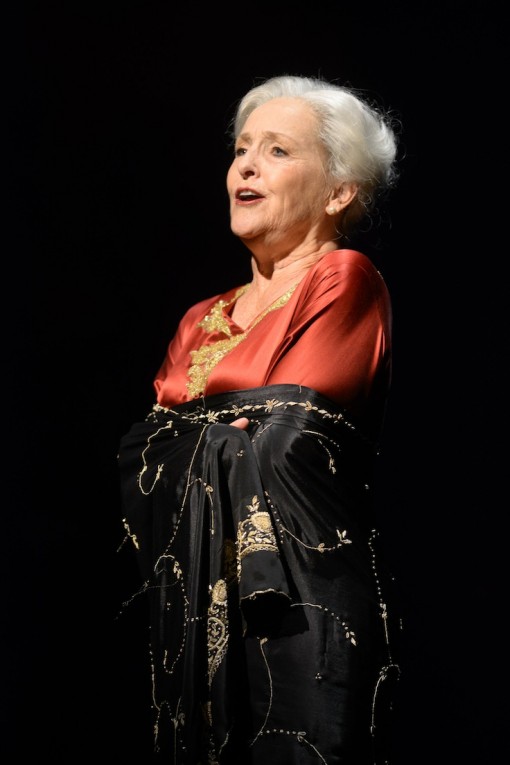Even with von Stade, Gordon’s inert “Coffin” is a deadly night in Philadelphia

Frederica von Stade stars in Ricky Ian Gordon’s “A Coffin in Egypt” at Opera Philadelphia. Photo: Kelly & Massa
Opera singers sometimes have had second careers in music theater or other lighter genres, from Ezio Pinza to Kathleen Battle and Jessye Norman. We might add to that list the beloved American mezzo-soprano Frederica von Stade, who has returned to the stage this spring in a new music theater piece composed for her by Ricky Ian Gordon. After premieres in Houston and Los Angeles, A Coffin in Egypt arrived at Philadelphia’s Kimmel Center on Friday night, with von Stade making her company debut at Opera Philadelphia in the lead.
Gordon identifies the work as an opera, but with extended scenes in spoken dialogue, amplified voices, and a nine-part instrumental ensemble, A Coffin in Egypt sits more comfortably alongside Gordon’s other Broadway work. The libretto by Leonard Foglia, equally at home in Broadway style, reworks the play In a Coffin in Egypt by Texas-born playwright and screenwriter Horton Foote.
As adapted by Foglia and Gordon, it becomes an overlong, rambling, whiny monologue by Myrtle Bledsoe, a ninety-year-old Texas matriarch who has outlived her philandering husband and two daughters and, now facing death herself, grapples with the memories and fantasies of a long life.
The white-haired Von Stade, costumed in a red silk dressing gown, remains a regal presence on stage. Vocally faded, her appearance here could have easily come off as the sad spectacle of a once-great singer desperately holding onto the spotlight, especially since she supposedly retired from singing three years ago. That it was not is a testament to her ability to hold dramatic attention, both while singing and in her more nuanced spoken lines. Somehow she made Myrtle sympathetic, and it was clear that she believed in the character and in Gordon and Foglia’s ideas, even though that belief seemed misplaced to me.
The work itself needs drastic revision, beginning with some cuts. Because it is essentially a long monologue for Myrtle, the crushing weight of so much narration, much of which is heard more than once as Myrtle, forgetful, repeats herself, renders the piece dramatically inert. The spoken interludes, as Myrtle relives past scenes with her husband and other family members (portrayed well by actors David Matranga and Carolyn Johnson, among others), interrupt the flow of the music’s potential arc. For example, perhaps the most successful monologue piece of this type, Poulenc’s gripping La Voix Humaine, is about half the length of A Coffin in Egypt.
Gordon writes in a mostly consonant harmonic idiom, the small group of instruments often given swirling motifs but little that moves the ear. Most oddly for a Broadway composer, no tune stuck in my memory either. The repetition of a melody’s concluding motif by an instrument in the pit, a tic of many music theater scores, was a crutch used far too often. To provide some relief from the monotony of style in the arias for Myrtle, Gordon relies on periodic appearances of a Gospel quartet, sung with conviction if not ideal balance by Veronica Chapman-Smith, Julie-Ann Green, Taiwan Norris, and Frank Mitchell.
Leonard Foglia, in his program note, describes working with Horton Foote when he directed the play version, which included recording actual Gospel singing in an African-American church to be played during the performance. Gordon attempted to capture that sound in his writing for the Gospel quartet, but the results are thin and disappointing. The quartet music provides a sort of Gospel veneer, with whiffs of the expected harmony and rhythm, but nothing of the church-filling, tongues-inducing sound that Foglia describes and that anyone who has ever heard the real thing live understands.
The barren prairie of Myrtle’s Texas estate is evoked by a scrolling backdrop of yellow and brown vegetation, and a few chairs on a step suggest a broad porch. The eras of Myrtle’s memories are evoked with often hilarious wigs, glasses, and costumes (set and costume design by Riccardo Hernández, stage direction by Foglia) and a few lighting changes (designed by Brian Nason). Timothy Myers, who also conducted the work in Houston and Los Angeles, provided assured leadership at the podium, and the nine musicians in the pit played with skill and confidence.
A Coffin in Egypt runs through June 15 at the Perelman Theater in the Kimmel Center. operaphila.org
Posted Jun 10, 2014 at 7:19 pm by Dick Bruce
It’s a while since I’ve seen her on stage, and she has indeed aged a bit. But then she will be 70 next year, and like a lot of people of that age, you can now see her personality in her face. The warmth, gentleness, wisdom and generosity that almost everyone that has ever known her mentions seems to radiate from her!
“Vocally faded” seems a bit of a kick in the guts to those of us that remember perhaps the finest Cherubino the world has ever known, and are eternally devoted to her; but that’s presumably why she stopped singing opera 2 years ago. In her pomp she had a timbre which is immediately distinctive and, especially in Mozart and Rossini, had extraordinary beauty and expressed the sheer joy in what she was singing like no other. And otherwise this piece is a sympathetic appreciation of the one of the finest artists and loveliest human beings that has graced the opera stage in living memory.